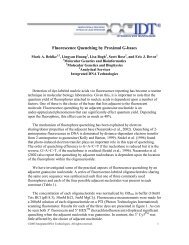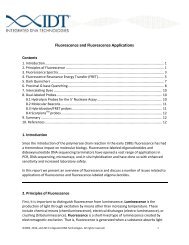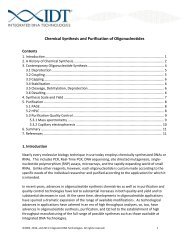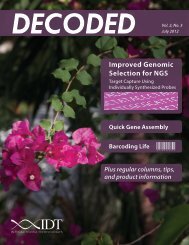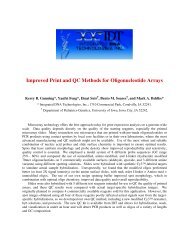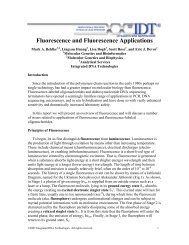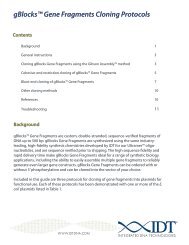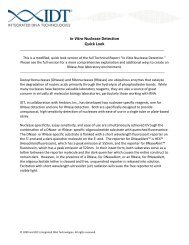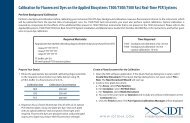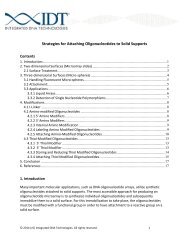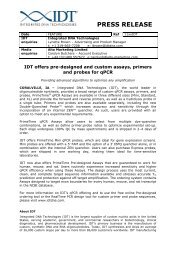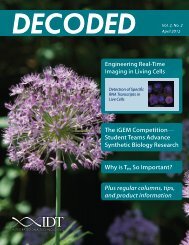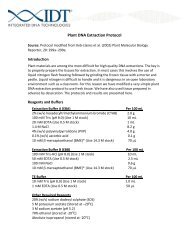Introducing Antisense Oligonucleotides into Cells - Integrated DNA ...
Introducing Antisense Oligonucleotides into Cells - Integrated DNA ...
Introducing Antisense Oligonucleotides into Cells - Integrated DNA ...
Create successful ePaper yourself
Turn your PDF publications into a flip-book with our unique Google optimized e-Paper software.
<strong>Introducing</strong> <strong>Antisense</strong> <strong>Oligonucleotides</strong> <strong>into</strong> <strong>Cells</strong><br />
Contents<br />
1. Introduction ................................................................................................................................ 1<br />
2. Controls ....................................................................................................................................... 2<br />
3. Oligonucleotide Uptake .............................................................................................................. 2<br />
3.1 Receptor-mediated endocytosis ........................................................................................... 3<br />
3.2 Microinjection ....................................................................................................................... 3<br />
3.3 Cationic Lipids ....................................................................................................................... 3<br />
3.3.1 Modified Liposomes ....................................................................................................... 4<br />
3.3.2 Available at IDT: TriFECTin TM Transfection Reagent ...................................................... 5<br />
3.4 Electroporation ..................................................................................................................... 5<br />
3.5 Other Methods of Facilitated Entry ...................................................................................... 5<br />
3.6 In vivo delivery systems ........................................................................................................ 6<br />
4. Conclusion ................................................................................................................................... 6<br />
5. References .................................................................................................................................. 6<br />
1. Introduction<br />
The choice of sequence and chemistry of the antisense oligonucleotide is crucial to the success<br />
of any given experiment [1]. In addition to choosing the optimal chemistry, the researcher must<br />
decide upon a target site within the gene of interest. This entails looking at the possible crossreactivity<br />
with non-target genes, as well as considering the conformational and thermodynamic<br />
characteristics of both the site and the probe. In addition, the investigator must carefully check<br />
the antisense oligonucleotide to make certain it doesn’t contain sequences that might evoke<br />
biological responses unrelated to the down regulation of the targeted gene.<br />
A successful antisense experiment depends on the following characteristics [2]:<br />
• Unique <strong>DNA</strong> sequence<br />
• Efficient cellular uptake<br />
• Minimal nonspecific binding<br />
• Target specific hybridization<br />
• Non-toxic antisense construct<br />
• Nuclease resistant chemistry to protect the antisense oligonucleotide (ASO)<br />
• Minimal inflammatory or immune response<br />
• Demonstration of reduction in target mRNA<br />
• Appropriate controls<br />
©2005, 2010, and 2011 <strong>Integrated</strong> <strong>DNA</strong> Technologies. All rights reserved. 1
Once the antisense sequence is specified, the investigator must then design the controls. It is<br />
important to assess any unforeseen effects of the antisense oligonucleotide. The researcher<br />
must also consider the best way to deliver the probe to the internal workings of the cell where<br />
the probe can down regulate the gene of interest.<br />
2. Controls<br />
Experienced researchers have learned that antisense oligonucleotides can incite unexpected<br />
biological and pharmacological effects. These effects highlight the need for good controls.<br />
Researchers wishing to use antisense as a tool are not always aware of the pitfalls and, thus,<br />
many studies are still poorly controlled. The behavior of an oligonucleotide in a cell or other<br />
biological environment may be influenced by its base composition and by global properties<br />
such as conformation. No perfect control exists; therefore multiple controls should always be<br />
used [3]. Controls are divided <strong>into</strong> four types:<br />
Oligonucleotide sequences that maintain structural features, such as hairpins, but<br />
have different base compositions from the antisense.<br />
Scrambled oligonucleotide sequences that have the same base compositions as the<br />
antisense but not the same structural features, such as hairpins.<br />
<strong>Antisense</strong> oligonucleotide sequences with one or more mismatches to show<br />
whether the target is selectively hybridized.<br />
Use of cell lines in which the target gene is mutated or deleted or rescue of<br />
phenotype with transfection of a codon-varied version of the target gene that the<br />
ASO cannot target.<br />
Using a variety of controls strengthens confidence in interpreting antisense experiments.<br />
Moreover, results will have the greatest believability when the levels of the target RNA and its<br />
expressed protein are directly measured.<br />
3. Oligonucleotide Uptake<br />
<strong>Oligonucleotides</strong> may be introduced to cells by a variety of methods:<br />
• Receptor-mediated endocytosis<br />
• Microinjection<br />
• Cationic Lipids/Liposomes<br />
• Electroporation<br />
• Other methods of facilitated entry<br />
• In vivo delivery systems<br />
©2005, 2010, and 2011 <strong>Integrated</strong> <strong>DNA</strong> Technologies. All rights reserved. 2
3.1 Receptor-mediated endocytosis<br />
Receptor-mediated endocytosis occurs when the plasma membrane of a cell buds inward to<br />
form a vesicle which contains receptor sites. Molecules from outside the cell specifically bind to<br />
these receptor sites and are internalized <strong>into</strong> the cell. Oligonucleotide entry <strong>into</strong> living cells has<br />
been shown to occur through receptor-mediated endocytosis with small oligonucleotides taken<br />
up more rapidly than long oligonucleotides. This uptake can be competitively inhibited by other<br />
small oligonucleotides, especially if they contain a 5' phosphate. Uptake is temperaturedependent,<br />
occurring more rapidly at 37 o C than at 4 o C. Modifying the oligonucleotide can<br />
change its uptake efficiency. Tissue culture cells bind and internalize phosphorothioatemodified<br />
oligonucleotides better than they do phosphodiester oligonucleotides or<br />
methylphosphonates [4]. Oligonucleotide uptake by this mechanism is inefficient and seems to<br />
deposit the oligonucleotides <strong>into</strong> nonnuclear intracellular compartments that are largely<br />
inaccessible to RNA [5]. As a general rule, it appears more effective to use methods to directly<br />
facilitate oligonucleotide entry <strong>into</strong> the cell. Some investigators have suggested that any effects<br />
shown by endocytosed oligonucleotides may have been induced through sequenceindependent<br />
mechanisms [6].<br />
3.2 Microinjection<br />
Microinjection is the process whereby a micropipette is used to deliver materials <strong>into</strong> single<br />
living cells. Microinjecting oligonucleotides <strong>into</strong> cells results in rapid accumulation of the<br />
oligonucleotide in the nucleus [7, 8] . It is important to note that when delivering an<br />
oligonucleotide directly <strong>into</strong> cells, the researcher can limit toxicity by controlling the purity of<br />
the preparation. One method used to ensure purity for microinjection is to use a series of HPLC<br />
and gel filtration steps to further purify the oligonucleotide [9]. Unfortunately, microinjection<br />
cannot be used in many in vivo studies and can only treat a limited number of cells.<br />
3.3 Cationic Lipids<br />
Cationic lipids are positively charged lipids which interact with the negatively charged <strong>DNA</strong> and<br />
cell membranes. Through these interactions, they are able to internalize the negatively charged<br />
<strong>DNA</strong> <strong>into</strong> the cells. Cationic lipids are commonly used to facilitate the entry of a variety of<br />
compounds, including antisense oligonucleotides, <strong>into</strong> living cells [10]. In one series of<br />
experiments, the cationic lipid reagent Lipofectin (Invitrogen Life Technologies) was shown to<br />
enhance the entry of an 18-mer phosphorothioate oligonucleotide <strong>into</strong> HUVEC cells by 20-fold<br />
and to effect a 1000-fold increase in biological antisense activity. These results were obtained<br />
with an 8 M concentration of Lipofectin; the reagent became toxic when increased to 16 μM.<br />
Cationic lipids do not appear to directly transport <strong>DNA</strong> <strong>into</strong> the cellular cytoplasm. Rather, a<br />
complex multistage process occurs. First, a <strong>DNA</strong>:cationic lipid complex is internalized in an<br />
endosome. Anionic lipids on the cytoplasmic face of the endosome fuse with the cationic<br />
transfection agent, and the oligonucleotide is displaced <strong>into</strong> the cytoplasm [11].<br />
<strong>Oligonucleotides</strong> that have been introduced through lipofectin-induced uptake are diffusely<br />
distributed in the cytoplasm and the nucleus [12]. This distribution presumably results in<br />
greater oligonucleotide bioavailability and a subsequent enhancement in the antisense effect<br />
[13-15].<br />
©2005, 2010, and 2011 <strong>Integrated</strong> <strong>DNA</strong> Technologies. All rights reserved. 3
Cationic lipids must be used with caution and with appropriate controls as cell growth is<br />
inhibited by DOTMA, the cationic detergent in Lipofectin, in a linear dose-dependent fashion in<br />
some cell lines. [16]. Cationic detergents may not be useful in promoting oligonucleotide<br />
uptake in all cell types. In one study, keratinocytes were found to take up phosphorothioate<br />
oligonucleotides equally well both with and without Lipofectin [17]. Lipid-based agents other<br />
than Lipofectin have been used to enhance oligonucleotide uptake <strong>into</strong> cells. Different cell lines<br />
and different forms of <strong>DNA</strong> (single-stranded oligonucleotides, circular plasmids, etc.) may each<br />
have a different optimal lipid agent. Further, different chemically modified forms of <strong>DNA</strong> may<br />
require re-optimization of the transfection procedure [18]. The precise agent used, the ratio of<br />
<strong>DNA</strong> to lipid, and the liposome complexation volumes may each require optimization [19]. In<br />
addition, not all lipid-based agents can be used in the presence of serum [20].<br />
By encapsulating concentrated oligonucleotides in lipid vesicles, the oligos can be protected<br />
from attack by nucleases in serum. In this way, the lipid vesicles can support delivery of intact<br />
oligos <strong>into</strong> the cells. In one described method, cardiolipin, phosphatidylcholine, and cholesterol<br />
were mixed at a 0.5:10:7 molar ratio, and combined with an antisense oligonucleotide. This<br />
formulation resulted in a final product that contained 60–70 μg oligonucleotide/mg lipid.<br />
Natural phosphodiester oligonucleotides are stable in serum for days when encapsulated in<br />
such liposomes and liposomal delivery increased oligonucleotide uptake about 20-fold <strong>into</strong><br />
MOLT3 cells and resulted in diffuse cytoplasmic and nuclear localization [21].<br />
Even with the use of lipid agents to promote transfection, oligonucleotide entry <strong>into</strong> individual<br />
cells can vary dramatically. Vaughn et al. used a fluorescence-activated cell sorter to assess cellto-cell<br />
variability [22]. <strong>Cells</strong> were incubated with fluorescein-labeled phosphorothioate<br />
antisense oligonucleotides targeting the ERBB2 message. <strong>Cells</strong> were later incubated with a<br />
cascade blue–labeled anti-ERBB2 antibody. Evaluation of dual-fluorescence spectra indicated<br />
that cells having higher levels of antisense oligonucleotide had much lower levels of ERBB2<br />
protein. Potent antisense effect was observed with approximately 10 7 antisense molecules per<br />
cell.<br />
3.3.1 Modified Liposomes<br />
Liposomes can be made for this application by a number of slightly different techniques [23].<br />
Moreover, liposomes can be modified in a number of ways that enhance their ability to deliver<br />
nucleic acids <strong>into</strong> living cells. The addition of certain viral coat proteins can increase the<br />
efficiency of fusion and uptake several fold. Polyoma virus pseudocapsids have been shown to<br />
be efficient carriers of nucleic acids <strong>into</strong> mammalian cells. These transfection vehicles contain<br />
pure viral VP1 protein produced in vitro using the baculovirus insect cell system and are free of<br />
other viral proteins and genetic material. Their use can enhance delivery of transfected <strong>DNA</strong><br />
many fold over unmodified liposomes [24].<br />
It is also possible to take advantage of natural import pathways to introduce foreign material<br />
<strong>into</strong> living cells. Vitamins such as folic acid are actively imported in this way [25]. Folate-binding<br />
protein (FBP) resides in the cell membrane and is responsible for the active uptake of folate via<br />
©2005, 2010, and 2011 <strong>Integrated</strong> <strong>DNA</strong> Technologies. All rights reserved. 4
eceptor-mediated endocytosis. This transport system is very efficient and has a K d in the<br />
nanomolar range. If liposomes are tagged with folate using a long 250-Å polyethylene glycol<br />
(PEG) spacer, steric hindrance is minimized and the liposomes are imported [26]. PEG addition<br />
also seems to prolong liposome survival in vivo by interfering with their clearance by the<br />
reticuloendothelial system. <strong>Oligonucleotides</strong> packaged <strong>into</strong> liposomes and delivered to cells are<br />
protected from serum nucleases. Unmodified phosphodiester oligonucleotides encapsulated in<br />
folate–PEG liposomes have been shown to invoke antisense activity equivalent to that of<br />
similarly encapsulated phosphorothioate-modified oligonucleotides.<br />
3.3.2 Available at IDT: TriFECTin TM Transfection Reagent<br />
TriFECTin is a proprietary cationic lipid formulation that has been optimized for delivery of IDT’s<br />
Dicer-Substrate siRNAs <strong>into</strong> a wide variety of cell types with minimal toxicity. For more<br />
information and to order TriFECTin, please visit the IDT website.<br />
3.4 Electroporation<br />
Electroporation is a process used to transform or transfect a wide variety of cell types through<br />
the use of an externally applied electrical field. The charge affects the permeability of the cell<br />
plasma membrane which allows for the entrance of the intended insert. Electroporation is<br />
efficient at delivering a large amount of nucleic acid to a cell. It is a useful procedure for<br />
delivery to cells which are difficult to transfect. Electroporation requires a large amount of<br />
delivered material (typically 500 nM – 2 in order to work efficiently. The process does<br />
introduce an increased risk of toxicity to the cells which must be treated very carefully following<br />
the applied electrical field in order to survive.<br />
3.5 Other Methods of Facilitated Entry<br />
• Pretreatment of cells with streptolysin O led to a 100-fold increase in oligonucleotide<br />
permeation with minimal cellular toxicity [27].<br />
• Cell Penetrating Peptides (CPPs): The attennapedia homeodomain protein is<br />
translocated through cell membranes and targeted to nuclear localization. A 16 amino<br />
acid peptide fragment from the third helix has been shown to confer this property to<br />
the protein [28]. Investigators have used this peptide coupled to an antisense<br />
oligonucleotide to facilitate direct entry of the oligonucleotide <strong>into</strong> the nucleus, giving<br />
high efficiency of penetration with low dosing. Use of this agent was compatible with<br />
serum-containing tissue culture medium and seemed to protect the oligonucleotide<br />
from nucleolytic degradation which enabled the use of phosphodiester <strong>DNA</strong> as an<br />
antisense agent [29]. This peptide is commercially available with a sulfhydryl-modifier<br />
enabling its attachment to a SH-modified oligonucleotide (Penetratin by Qbiogene).<br />
• Small molecule tags used to modify oligonucleotides improve their uptake efficiency.<br />
These types of tags include cholesterol-modification, membrane-permeant peptides,<br />
folate, antibiotics, VITE, and VITA [30].<br />
• Cationic polymers can bind to large nucleic acids and condense them <strong>into</strong> stable<br />
nanoparticles and can, thus, serve as efficient transfection agents.<br />
©2005, 2010, and 2011 <strong>Integrated</strong> <strong>DNA</strong> Technologies. All rights reserved. 5
3.6 In vivo delivery systems<br />
• Proteins derived from the coat of Sendai viruses are known to promote fusion of lipid<br />
bilayers. In one series of experiments, oligonucleotides were packaged in liposomes<br />
which were complexed with coat proteins derived from the hemagglutinating virus of<br />
Japan (HVJ, a Sendai family virus) and were infused <strong>into</strong> rat carotid arteries where they<br />
fused with the vascular endothelium and neointima. The oligonucleotides were able to<br />
curtail intimal hyperplasia following vascular injury [31, 32].<br />
• It is possible to use fluorescein-conjugated antisense oligonucleotides to track their fate<br />
in vivo. <strong>Oligonucleotides</strong> delivered via liposome encapsulation can be detected in the<br />
nucleus for up to two weeks after administration [31].<br />
• <strong>Antisense</strong> uptake <strong>into</strong> tissues in living organisms using intravenous, subcutaneous, or<br />
intraperitoneal injections has been higher than expected based on previous experience<br />
with cell culture [33].<br />
• Certain tissues are accessible to topical or localized administration of siRNA including<br />
the eye, mucus membranes, and local tumors [30].<br />
• Phosphorylated <strong>DNA</strong> antisense oligonucleotides have appreciable uptake in vivo.<br />
4. Conclusion<br />
<strong>Antisense</strong> technology represents a powerful technology for functional genomics and rational<br />
therapeutics. A number of parameters need to be considered when designing <strong>Antisense</strong><br />
experiments including oligonucleotide sequence, structure and purity, secondary structure of<br />
the target RNA, mechanism of action, and the process chosen to introduce the <strong>Antisense</strong><br />
oligonucleotide <strong>into</strong> the cell. Cellular uptake of phosphorothioate oligonucleotides is highly<br />
variable depending on a number of conditions including cell type, kinetics of uptake, tissue<br />
culture conditions and oligonucleotide chemical class [34, 35]. Conclusions about in vitro uptake<br />
must be made carefully and generalizations are impossible [34].<br />
5. References<br />
1. Stein CA and Cheng YC. (1993) <strong>Antisense</strong> oligonucleotides as therapeutic agents--is the<br />
bullet really magical? Science, 261(5124): 1004 1012.<br />
2. Phillips MI and Zhang YC. (2000) Basic principles of using antisense oligonucleotides in<br />
vivo. Methods Enzymol, 313: 46 56.<br />
3. Stein CA and Krieg AM. (1994) Problems in interpretation of data derived from in vitro<br />
and in vivo use of antisense oligodeoxynucleotides. <strong>Antisense</strong> Res Dev, 4(2): 67 69.<br />
4. Zhao Q, Matson S, et al. (1993) Comparison of cellular binding and uptake of antisense<br />
phosphodiester, phosphorothioate, and mixed phosphorothioate and<br />
methylphosphonate oligonucleotides. <strong>Antisense</strong> Res Dev, 3(1): 53 66.<br />
©2005, 2010, and 2011 <strong>Integrated</strong> <strong>DNA</strong> Technologies. All rights reserved. 6
5. Jaroszewski JW, Syi JL, et al. (1993) Targeting of antisense <strong>DNA</strong>: comparison of activity of<br />
anti-rabbit beta-globin oligodeoxyribonucleoside phosphorothioates with computer<br />
predictions of mRNA folding. <strong>Antisense</strong> Res Dev, 3(4): 339 348.<br />
6. Bonham MA, Brown S, et al. (1995) An assessment of the antisense properties of RNase<br />
H-competent and steric-blocking oligomers. Nucleic Acids Res, 23(7): 1197 1203.<br />
7. Chin DJ, Green GA, et al. (1990) Rapid nuclear accumulation of injected<br />
oligodeoxyribonucleotides. New Biol, 2(12): 1091 1100.<br />
8. Fisher TL, Terhorst T, et al. (1993) Intracellular disposition and metabolism of<br />
fluorescently-labeled unmodified and modified oligonucleotides microinjected <strong>into</strong><br />
mammalian cells. Nucleic Acids Res, 21(16): 3857 3865.<br />
9. Woolf TM, Jennings CG, et al. (1990) The stability, toxicity and effectiveness of<br />
unmodified and phosphorothioate antisense oligodeoxynucleotides in Xenopus oocytes<br />
and embryos. Nucleic Acids Res, 18(7): 1763 1769.<br />
10. Juliano RL and Akhtar S. (1992) Liposomes as a drug delivery system for antisense<br />
oligonucleotides. <strong>Antisense</strong> Res Dev, 2(2): 165 176.<br />
11. Zelphati O, and Szoka FC Jr. (1996) Mechanism of oligonucleotide release from cationic<br />
liposomes. Proc Natl Acad Sci U S A, 93(21): 11493 11498.<br />
12. Dheur S, and Saison-Behmoaras TE. (2000) Polyethyleneimine-mediated transfection to<br />
improve antisense activity of 3'-capped phosphodiester oligonucleotides. Methods<br />
Enzymol, 313: 56 73.<br />
13. Bennett CF, Chiang MY, et al. (1992) Cationic lipids enhance cellular uptake and activity<br />
of phosphorothioate antisense oligonucleotides. Mol Pharmacol, 41(6): 1023 1033.<br />
14. Chiang MY, Chan H, et al. (1991) <strong>Antisense</strong> oligonucleotides inhibit intercellular<br />
adhesion molecule 1 expression by two distinct mechanisms. J Biol Chem, 266(27):<br />
18162 18171.<br />
15. Colige A, Sokolov BP, et al. (1993) Use of an antisense oligonucleotide to inhibit<br />
expression of a mutated human procollagen gene (COL1A1) in transfected mouse 3T3<br />
cells. Biochemistry, 32(1): 7 11.<br />
16. Yeoman LC, Danels YJ, and Lynch MJ. (1992) Lipofectin enhances cellular uptake of<br />
antisense <strong>DNA</strong> while inhibiting tumor cell growth. <strong>Antisense</strong> Res Dev, 2(1): 51 59.<br />
17. Nestle FO, Mitra RS, et al. (1994) Cationic lipid is not required for uptake and selective<br />
inhibitory activity of ICAM-1 phosphorothioate antisense oligonucleotides in<br />
keratinocytes. J Invest Dermatol, 103(4): 569 575.<br />
18. Conrad AH, Behlke MA, et al. (1998) Optimal lipofection reagent varies with the<br />
molecular modifications of the <strong>DNA</strong>. <strong>Antisense</strong> Nucleic Acid Drug Dev, 8(5): 427 434.<br />
19. Staggs DR, Burton DW, and Deftos LJ. (1996) Importance of liposome complexing<br />
volume in transfection optimization. Biotechniques, 21(5): 792, 784, 796, 798.<br />
20. Lewis JG, Lin KY, et al. (1996) A serum-resistant cytofectin for cellular delivery of<br />
antisense oligodeoxynucleotides and plasmid <strong>DNA</strong>. Proc Natl Acad Sci U S A, 93(8):<br />
3176 3181.<br />
21. Thierry AR and Dritschilo A. (1992) Intracellular availability of unmodified,<br />
phosphorothioated and liposomally encapsulated oligodeoxynucleotides for antisense<br />
activity. Nucleic Acids Res, 20(21): 5691 5698.<br />
©2005, 2010, and 2011 <strong>Integrated</strong> <strong>DNA</strong> Technologies. All rights reserved. 7
22. Vaughn JP, Iglehart JD, et al. (1995) <strong>Antisense</strong> <strong>DNA</strong> downregulation of the ERBB2<br />
oncogene measured by a flow cytometric assay. Proc Natl Acad Sci U S A, 92(18):<br />
8338 8342.<br />
23. Hope MJ, Bally MB, et al. (1985) Production of large unilamellar vesicles by a rapid<br />
extrusion procedure. Characterization of size distribution, trapped volume and ability to<br />
maintain a membrane potential. Biochim Biophys Acta - Biomembranes, 812(1): 55 65.<br />
24. Forstova J, Krauzewicz N, et al. (1995) Polyoma virus pseudocapsids as efficient carriers<br />
of heterologous <strong>DNA</strong> <strong>into</strong> mammalian cells. Hum Gene Ther, 6(3): 297 306.<br />
25. Leamon CP and Low PS. (1991) Delivery of macromolecules <strong>into</strong> living cells: a method<br />
that exploits folate receptor endocytosis. Proc Natl Acad Sci U S A, 88(13): 5572 5576.<br />
26. Lee RJ and Low PS. (1994) Delivery of liposomes <strong>into</strong> cultured KB cells via folate<br />
receptor-mediated endocytosis. J Biol Chem, 269(5): 3198 3204.<br />
27. Spiller DG and Tidd DM. (1995) Nuclear delivery of antisense oligodeoxynucleotides<br />
through reversible permeabilization of human leukemia cells with streptolysin O.<br />
<strong>Antisense</strong> Res Dev, 5(1): 13 21.<br />
28. Derossi D, Joliot AH, et al. (1994) The third helix of the Antennapedia homeodomain<br />
translocates through biological membranes. J Biol Chem, 269(14): 10444 10450.<br />
29. Troy CM, Derossi D, et al. (1996) Downregulation of Cu/Zn superoxide dismutase leads<br />
to cell death via the nitric oxide-peroxynitrite pathway. J Neurosci, 16(1): 253 261.<br />
30. Whitehead KA, Langer R, and Anderson DG. (2009) Knocking down barriers: advances in<br />
siRNA delivery. Nat Rev Drug Discov, 8(2): 129 138.<br />
31. Morishita R, Gibbons GH, et al. (1994) Intimal hyperplasia after vascular injury is<br />
inhibited by antisense cdk 2 kinase oligonucleotides. J Clin Invest, 93(4): 1458 1464.<br />
32. Morishita R, Gibbons GH, et al. (1993) Single intraluminal delivery of antisense cdc2<br />
kinase and proliferating-cell nuclear antigen oligonucleotides results in chronic<br />
inhibition of neointimal hyperplasia. Proc Natl Acad Sci U S A, 90(18): 8474 8478.<br />
33. Agrawal S. (1996) <strong>Antisense</strong> oligonucleotides: towards clinical trials. Trends Biotechnol,<br />
14(10): 376 387.<br />
34. Crooke RM. (1991) In vitro toxicology and pharmacokinetics of antisense<br />
oligonucleotides. Anticancer Drug Des, 6(6): 609 646.<br />
35. Crooke ST, Grillone LR, et al. (1994) A pharmacokinetic evaluation of 14C-labeled<br />
afovirsen sodium in patients with genital warts. Clin Pharmacol Ther, 56(6 Pt 1):<br />
641 646.<br />
©2005, 2010, and 2011 <strong>Integrated</strong> <strong>DNA</strong> Technologies. All rights reserved. 8



